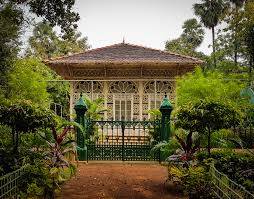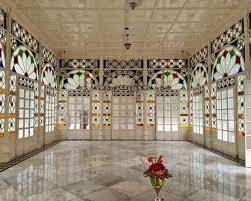
INTRODUCTION
Santiniketan, the abode of peace, was established in the 1860s by Maharshi Debendranath Tagore and was made a Brahmo Samaj Ashram. He was very much impressed by a grove of Chhatim trees, scientifically known as Alstonia scholaris, which is used for meditation. After that, he felt a peace under this and gave it a name, Santiniketan. That’s why Santiniketan is also called the abode of peace. In 1893, he established a small Santiniketan Griha as a form of prayer and meditation hall for Brahmo Samaj gatherings, and by 1890 to 1891, he came up with the idea of setting up a grand prayer hall, which is called the Upasana Griha, on the same site. The whole design and grandeur of this prayer hall are made up of glass, which is why it is locally known as Kaach Mandir. In this current scenario, Santiniketan is being declared as a heritage site by UNESCO in 2023, and the Upasana Griha is cited among the 41 heritage sites, and the recognized Upasana Griha is “the revivalism as well as the reinterpretation of sacred religious ideas.” This prayer hall is one of the most visited and even the crucial focal point for various festivals conducted by Visva Bharati, such as Poush Mela, etc.

ARCHITECTURAL FEATURES AND MATERIALS
The architectural structure of Upasana Grisha is like a small pavilion that is formed by a prefabricated cast-iron frame, and they are adorned with various colorful glasses, panels, and terracotta tile roofs. The design and the structure of this prayer hall are an inspiration taken from the 19th-century European glass structure, mainly the Crystal Palace of London in 1851. The whole prayer hall is standing on a raised sandstone terrace structure, attached with cast-iron columns, and the roof is supported by a latticework. The walls are decorated with Belgian stained glass, which is various colorful glazed glass. From the ancient past, we have seen that the Indian temples were basically made up of bricks and stones to enclose a deity chamber, but in the case of Upasana Griha, it breaks that kind of notion. This prayer hall doesn’t include any deity or a god or goddess sculpture, and instead it is an open pavilion that has large glass windows and doors on all four sides. The rooftop is made up of terracotta tiles, which are very visible from the interior, and the floor is simple and subtle, made up of sandstone. This whole artistic creation gives it a delicate, latten-like quality, which is very different from the massive stone temples of India.

ART MOTIFS AND SYMBOLISM IN DESIGN
The whole ornamentation of this Upasana Griha is spare but rich in its meaning, culture, and tradition. The stained glass is being designed with lotus flowers, floral patterns and intricate diamond or rhombus shapes. From the ancient Indian texts, the lotus denotes spiritual prosperity, and it denotes self-discovery and enlightenment in Hindu tradition. From the philosophy of Buddhism and Hinduism, the rising lotus art denotes the spiritual awakening in this muddy or dirty world. The repetition of a diamond- or rhombus-shaped pattern denotes harmony, peace, and order. In this whole Upasana Griha, we find only one religious symbol in the form of a design, which is the Greek Cross, or the equal-armed cross, that can be seen in the glass panes and terrace railings. The depiction of this Greek Cross denotes the acceptance and openness to other religions of the world, and this symbol denotes the Judeo-Christian and their ideas; it shows the universal spirit of faith. Various signs show the intermingling of both Indian and Western cultures, such as the lotus with floral arches. Thus, the overall structure of the Upasana Griha shows the Bengal Renaissance style architecture that combined folk with modern geometric shapes.

LEGACY AND INFLUENCE ON INDIAN ART AND EDUCATION
The influence of the artistic style and its depictions can be seen in Santiniketan’s enduring festivals and arts. One of the most auspicious occasions that is celebrated in Upasana Griha is the Christotsav, the annual Christmas celebration, which was started by Rabindranath Tagore in 1910, that shows the religious harmony, unity, and secular nature of the Upasana Griha. Another important festival is the Poush Mela, which is basically a fair conducted at the beginning of the harvest season in the Bengali month of Poush, usually in December. During both these festivals, the Upasana Griha is decorated with a folk art called Alpona that carries universal themes, which show the diverse yet profound cultural synthesis of Tagore’s vision for a more inclusive and harmonious society. If we study the Upasana Griha more intricately, it inspired the Santiniketan School of Art, which integrated both tribal folk art and modern Bengali motifs into modern art education through the Kala Bhavana. Every week, a prayer hall is conducted where students, teachers, and professors of Visva Bharati gather, and the students start their prayer by chanting Sanskrit mantras and Rabindra Sangeet, accompanied by tabla and harmonium. In Tagore’s view, both spiritual upliftment and artistic creativity are inseparable; both walk hand in hand.

CONCLUSION
In this article, to conclude that Upasana Griha is only an artistic building will not be justified, as it is beyond its limited boundary. It shows artistic creativity, spiritual upliftment, and socio-cultural harmony. This prayer hall, which was started by Debendranath Tagore, gained popularity from the period of Rabindranath Tagore and the establishment of Visva Bharati. It carries the vision of Tagore on how he wanted society to be based. The amalgamation of various artistic aesthetics creates its uniqueness, which integrates various religious ideas and shows its secular nature, and that’s why this Upasana Griha is unique in its nature.
WORKS CITED
- https://www.britannica.com/place/Shantiniketan
- https://acsforum.org/upasana-griha-shantiniketan-india-a-spiritual-sanctuary/#:~:text=practices.,Amra%20Kunj%20in%20the%20area
- https://www.cntraveller.in/story/santiniketan-is-now-a-unesco-world-heritage-site/#:~:text=Built%20by%20Tagore%E2%80%99s%20father%2C%20Debendranath,Bharati%20has%20become%20the%20first
- https://www.dailyartmagazine.com/lotus-timeless-symbol-in-hindu-iconography/#:~:text=Growing%20in%20muddy%20water%20yet,signifies%20enlightenment%20and%20spiritual%20awakening
- https://www.santiniketan.in/christotsav/#:~:text=Christoutsav%20also%20known%20as%20Christo,the%20teachings%20of%20Jesus%20Chris




